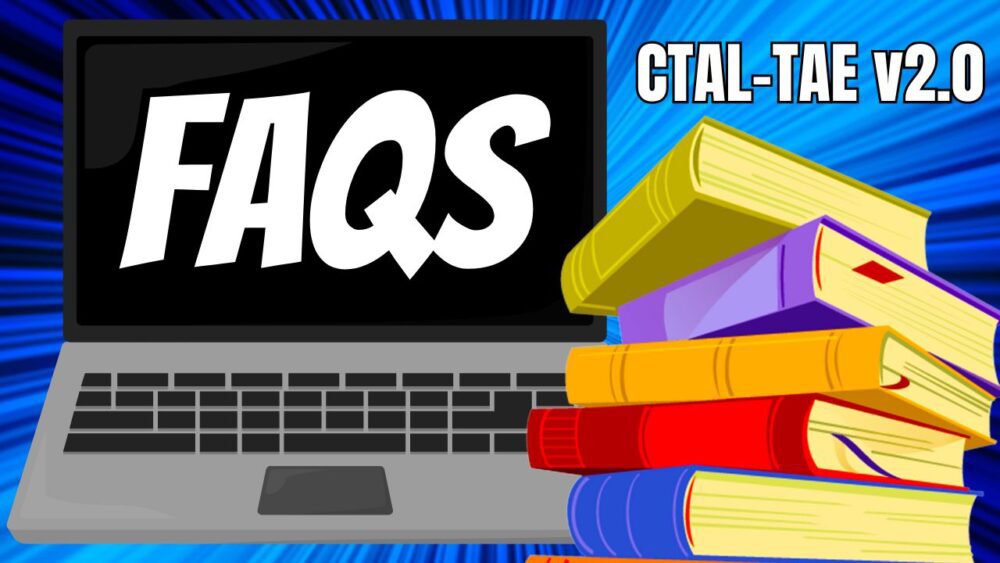Certified Tester Advanced Level Test Automation Engineering (CTAL-TAE) v2.0 Exam FAQs

1. What is the Certified Tester Advanced Level Test Automation Engineering (CTAL-TAE) v2.0 Exam?
The Certified Tester Advanced Level Test Automation Engineering (CTAL-TAE) certification is designed for professionals engaged in software testing and automation. It suits roles like testers, test analysts, automation engineers, test consultants, architects, managers, and developers. This certification also benefits individuals seeking foundational knowledge in test automation, including project managers, quality managers, software development managers, business analysts, IT directors, and management consultants.
2. What is the target audience for the Certified Tester Advanced Level Test Automation Engineering (CTAL-TAE) v2.0 exam?
The Test Automation Engineering syllabus is for test engineers aiming to establish or enhance test automation processes. It outlines effective practices and techniques to create a sustainable solution. While it references models and guidelines relevant to test automation—such as standards for software development lifecycles, programming practices, and formatting—it does not cover software engineering fundamentals. Test automation engineers, however, should have software engineering knowledge and experience.
In addition, familiarity with industry standards for programming and documentation is crucial for test automation engineers. Applying these standards can improve the maintainability, reliability, and security of automation solutions, as they are often rooted in quality-focused principles.
3. What are the key topics covered in the CTAL-TAE v2.0 syllabus?
The syllabus covers a wide range of topics, including:
- Chapter 1: 45 minutes – Introduction and Objectives for Test Automation
- Chapter 2: 180 minutes – Preparing for Test Automation
- Chapter 3: 210 minutes – Test Automation Architecture
- Chapter 4: 150 minutes – Implementing Test Automation
- Chapter 5: 90 minutes – Implementation and Deployment Strategies for Test Automation
- Chapter 6: 150 minutes – Test automation Reporting and Metrics
- Chapter 7: 135 minutes – Verifying the Test Automation Solution
- Chapter 8: 210 minutes – Continuous Improvement
4. What is the knowledge recommended for taking the Certified Tester Advanced Level Test Automation Engineering (CTAL-TAE) v2.0 exam?
To qualify for the Test Automation Engineering exam, candidates should ideally have an interest in software testing and automation. It is also highly recommended that they:
- Have some experience in software development or testing, ideally with at least six months as a software test engineer or software developer.
- Complete a training course accredited to ISTQB standards by an approved provider.
5. How can I prepare for the CTAL-TAE v2.0 exam?
- Study the official syllabus: Understand the key topics and subtopics.
- Utilize study materials: Refer to textbooks, online courses, and practice tests.
- Gain practical experience: Work on real-world test automation projects to solidify your skills.
- Join study groups: Collaborate with other test automation professionals to discuss concepts and share experiences.
- Practice with mock exams: Simulate exam conditions to assess your readiness.
6. What are the benefits of obtaining the CTAL-TAE v2.0 certification?
- Enhanced career prospects: Validate your expertise and increase your earning potential.
- Improved problem-solving skills: Develop a structured approach to complex test automation challenges.
- Recognition as an industry expert: Gain credibility and respect among peers and employers.
- Access to advanced career opportunities: Qualify for senior roles and leadership positions in test automation.
7. How can I choose the right test automation tools and frameworks?
Consider factors like:
- Project requirements: Identify the specific needs of your project.
- Team expertise: Evaluate the team’s skillset and familiarity with tools.
- Tool capabilities: Assess the features and limitations of different tools.
- Cost and licensing: Consider the budget and licensing terms.
- Maintenance and support: Evaluate the tool’s long-term support and maintenance.
8. What are some common challenges in test automation and how can they be addressed?
- Test automation flakiness: Implement robust test design, stable test environments, and effective error handling.
- Test maintenance overhead: Use modular test design, automated test generation, and self-healing tests.
- Tool limitations: Explore alternative tools or workarounds, or consider custom development.
- Skill gaps: Invest in training and upskilling your team.
9. How can I measure the effectiveness of test automation efforts?
- Key performance indicators (KPIs): Track metrics like test execution time, defect detection rate, and test coverage.
- Return on investment (ROI): Calculate the cost savings and benefits of test automation.
- Continuous improvement: Regularly review and refine your test automation strategy.
10. What are the future trends in test automation?
- AI and machine learning: Automated test case generation, self-healing tests, and intelligent test execution.
- Shift-left testing: Incorporate test automation into earlier phases of the development lifecycle.
- Cloud-based test automation: Leverage cloud infrastructure for scalable and flexible test environments.
- Low-code/no-code test automation: Empower non-technical testers to create and maintain automated tests.
11. How can I stay updated with the latest trends and best practices in test automation?
- Attend conferences and workshops: Network with industry experts and learn about emerging technologies.
- Read industry publications and blogs: Stay informed about the latest news and insights.
- Participate in online communities: Engage with other test automation professionals and share knowledge.
- Continuous learning: Pursue advanced certifications and training courses to enhance your skills.
12. What is the exam format?
The Certified Tester Advanced Level Test Automation Engineering (CTAL-TAE) v2.0 exam consists of 40 questions, totaling 64 points. To pass, candidates need a minimum score of 42 points. The exam duration is 90 minutes, with an additional 25% time allowance for non-native language speakers.
For More: Check Here

